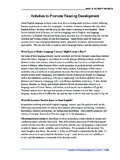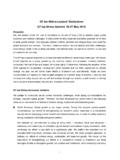Transcription of Strategic Plan to Promote the Development and ...
1 EPA Document# EPA-740-R1-8004 June 22, 2018 United States Office of Chemical Safety and Environmental Protection Agency Pollution Prevention Strategic Plan to Promote the Development and Implementation of Alternative Test Methods Within the TSCA Program June 22, 2018 1 Table of Contents 1. Executive Summary .. 6 2. Introduction .. 7 3. TSCA & Organization of this Strategic 9 4. Identification, Development , and Integration of NAMs .. 12 a. Opportunities to Deploy and Develop NAMs for TSCA .. 12 i. Chemical Characterization .. 12 ii. Hazard Identification and Characterization .. 13 iii. Dosimetry and In Vitro - In Vivo Extrapolation (IVIVE) .. 15 iv. Characterizing Exposure to Humans and the Environment.. 16 b. Integration of NAMs: Relevant Frameworks (AOP, IATA, Defined Approaches, Tiered Testing, Pathway Analysis) .. 17 5. Establishing Scientific Relevance, Reliability and Confidence of NAMs: Development of Criteria for TSCA-related Decisions.
2 19 6. The Importance of Education, Training and Collaboration: .. 21 7. Implementation of NAMs Under TSCA .. 22 a. Current to Near-Term Needs and Activities: Building a TSCA NAM Foundation (Now-3 years) .. 23 i. Continue to Implement NAMs to Evaluate Hazard, Exposure and Environmental Fate for New and Existing Chemicals .. 24 ii. Maintain and Regularly Update a List of NAMs per Section 4(h)(2)(C) .. 24 iii. Identify and Maintain a List of Most Requested/Needed Studies for New and Existing Chemicals Under TSCA .. 25 iv. Identify and Curate Available Existing TSCA Information on NAMs (And Traditional Test Data) .. 26 v. Use of NAMs to Identify Candidates for Prioritizing Existing Chemicals for TSCA Risk Evaluation .. 26 vi. Begin Development of Scientific Information Technology Platforms .. 27 vii. Collaborate with Partners and Stakeholders to Identify NAMs for Further Development .. 27 viii. Launch TSCA NAM 28 b. Intermediate-term Objectives: Building a Future TSCA with NAMs (3-5 years).
3 28 i. Review Retrospective and In-House Analyses to Identify Appropriate NAM Research Needs of Importance to TSCA .. 29 ii. Progress Towards Use of NAMs for Prioritization, Risk Evaluation, and Other Risk-Based Decisions .. 29 iii. Maintaining the Continual Expansion of the TSCA Section 4(h) List .. 29 2 iv. Developing and Maintaining Educational and Outreach Goals for Regulatory Scientists, End-Users and the Public .. 29 v. Continue Collaboration with Partners and Stakeholders to Identify NAMs for Further Development .. 30 c. Long-Term Goal: Reduce and Eventually Eliminate Vertebrate Animal Testing .. 30 8. Conclusions & Next Steps .. 30 References .. 32 Appendix: Reduction of Testing on Vertebrates (15 2603(h)) .. 36 3 ACKNOWLEDGEMENTS This report was developed by the United States Environmental Protection Agency ( EPA), Office of Chemical Safety and Pollution Prevention (OCSPP) [Offices of Pollution Prevention and Toxics (OPPT), Office of Science Coordination and Policy (OSCP) and the Office of Pesticide Programs (OPP)] and the Office of Research and Development (ORD) [the Immediate Office, the National Center for Computational Toxicology (NCCT) and the National Exposure Research Laboratory (NERL)].
4 DOCKET Supporting information can be found in the public docket: DISCLAIMER This Strategic Plan does not constitute rulemaking by the EPA and cannot be relied on to create a substantive or procedural right enforceable by any party in litigation with the United States. Non-mandatory language such as should and statements of what EPA will or plans to do explain EPA s current thinking and do not impose any legally binding requirements. Nor does this document determine what EPA will do in any particular case relating to Development of information. EPA expects to make changes to this living document at any time and therefore this document may be revised periodically. EPA welcomes public input on this document at any time. Suggested citation for this document: USEPA 2018. Strategic Plan to Promote the Development and Implementation of Alternative Test Methods Within the TSCA Program. June 22, 2018. Environmental Protection Agency, Office of Chemical Safety and Pollution Prevention, Washington, DC.
5 4 ABBREVIATIONS 3Rs Reduction, Refinement and Replacement AIM Analog Identification Method AOP Adverse Outcome Pathway CAAT Center for Alternatives to Animal Testing CBI Confidential Business Information CEM Consumer Exposure Model ChemSTEER Chemical Screening Tool for Exposures and Environmental Releases DA Defined Approach ECHA European Chemicals Agency ECOSAR Ecological Structure-Activity Relationships Program EDSP Endocrine Disruptor Screening and Testing Program E-FAST Exposure and Fate Assessment Screening Tool EPA Environmental Protection Agency EPIS uiteTM Estimation Programs Interface ER Estrogen Receptor EURL-ECVAM European Union Reference Laboratory for Alternatives to Animal Testing FDA Food and Drug Administration FIFRA Federal Insecticide, Fungicide and Rodenticide Act HESI Health and Environmental Science Institute IATA Integrated Approaches to Testing and Assessment ICATM International Cooperation on Alternative Test Methods ICCVAM Interagency Coordinating Committee on the Validation of Alternative Methods ICE Integrated Chemical Environment IVIVE In Vitro to In Vivo Extrapolation LLNA Local Lymph Node Assay MAD Mutual Acceptance of Data NCATS National Center for Advancing Translational Sciences NAM New Approach Methodologies NCCT National Center for Computational Toxicology NERL National Exposure Research Laboratory NIEHS National Institute of Environmental Health Sciences NIH National Institutes of Health NGO Non-Governmental Organization NICEATM NTP Interagency Center for the Evaluation of Alternative Test Methods NTP National Toxicology Program OCSPP Office of Chemical Safety and Pollution Prevention OECD
6 Organization for Economic Cooperation and Development OPP Office of Pesticide Programs OPPT Office of Pollution Prevention and Toxics ORD Office of Research and Development OSCP Office of Science Coordination and Policy PBTK Physiologically-Based Toxicokinetics PETA People for the Ethical Treatment of Animals 5 POD Point of Departure QSAR Quantitative Structure Activity Relationship SACC Science Advisory Committee on Chemicals SAR Structure Activity Relationship SBIR Small Business Innovation Research TK - Toxicokinetics TNT TSCA NAM Team TSCA Toxic Substances Control Act WOE Weight of Scientific Evidence 6 1. Executive Summary On June 22, 2016, the Toxic Substances Control Act (TSCA) was amended by the Frank R. Lautenberg Chemical Safety for the 21st Century Act. The EPA Office of Pollution Prevention and Toxics (OPPT) is responsible for carrying out the mandates of TSCA; which includes a new subsection that requires EPA to develop a Strategic Plan to Promote the Development and implementation of alternative test methods and strategies to reduce, refine or replace vertebrate animal testing and provide information of equivalent or better scientific quality and relevance for assessing risks of injury to health or the environment of chemical substances or mixtures (Section 4 (h), Reduction of Testing on Vertebrates).
7 In this document, EPA outlines its Strategic Plan for the reduction of testing in vertebrates for chemicals regulated under TSCA. The organizing framework for EPA s strategy to reduce vertebrate animal testing relies heavily on what have been termed new approach methodologies (NAMs). This phrase has been adopted as a broadly descriptive reference to any technology, methodology, approach, or combination thereof that can be used to provide information on chemical hazard and risk assessment that avoids the use of intact animals. Both new and existing chemicals subject to TSCA regulation cover a broad range of chemical space and lack standard information requirements. Therefore, EPA recognizes that this Strategic Plan necessarily describes a multi-year process with incremental steps for adoption and integration of NAMs that are appropriate and fit-for-purpose for making TSCA decisions ( , identifying candidates for prioritization, prioritization, risk evaluations for new and existing chemicals and other risk-based decisions).
8 NAMs would include methods that evaluate hazard (human health and environmental), exposure, and environmental fate as well as different approaches to integrate NAMs for decision making; , adverse outcome pathways (AOP), integrated approaches to testing and assessment (IATA), and defined approaches (DA). This Strategic Plan has three core components: (1) identifying, developing and integrating NAMs for TSCA decisions; (2) building confidence that the NAMs are scientifically reliable and relevant for TSCA decisions; and (3) implementing the reliable and relevant NAMs for TSCA decisions. EPA has identified eight current/near-term (<3 years) needs and activities. Completing these activities will result in moving towards five i ntermediate-term (3-5 years) objectives. These time frames, needs and activities provide the basis for developing NAMs, establishing reliability and relevance criteria for the NAMs, and implementing NAMs to inform decisions made under TSCA.
9 EPA s long-term goal is to move towards making TSCA decisions with NAMs in order to reduce, refine or replace vertebrate animal testing. Achieving this goal will require EPA to maintain a high level of commitment to identifying, developing, and integrating NAMs for implementation under TSCA and to work closely with stakeholders at every step. 7 To ensure the success of this Strategic Plan, EPA has established a n internal TSCA NAM Team (TNT) to take advantage of expertise and resources within the Agency. The TNT will oversee the implementation of this Strategic Plan and be responsible for collaborating with stakeholders and the public. The TSCA Section 4(h) List of NAMs can be found on the EPA webpage1. 2. Introduction The Toxic Substances Control Act (TSCA) was originally enacted in 1976 and serves as the nation s primary chemical management law. On June 22, 2016, TSCA was amended by the Frank R. Lautenberg Chemical Safety for the 21st Century Act (hereafter referred to as TSCA).
10 The EPA Office of Pollution Prevention and Toxics (OPPT) is responsible for administering TSCA, which includes new requirements and deadlines for actions related to the assessment and regulation of new and existing chemical substances. It also includes a new subsection under Section 4 (Testing of Chemical Substances and Mixtures) that requires EPA to develop a Strategic Plan to Promote the Development and implementation of alternative test methods and strategies to reduce, refine or replace vertebrate animal testing and provide information of equivalent or better scientific quality and relevance for assessing risks of injury to health or the environment of chemical substances or mixtures (Section 4 (h), Reduction of Testing on Vertebrates, see Appendix). Alternative test methods and strategies are two different descriptors that have a common goal. Reduction, refinement and replacement (the 3Rs) have been hallmark principles in defining alternative test methods for over 50 years (Russell and Burch, 1959).
















